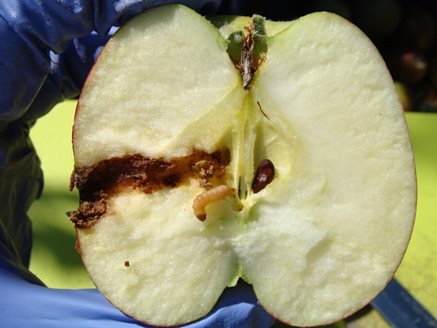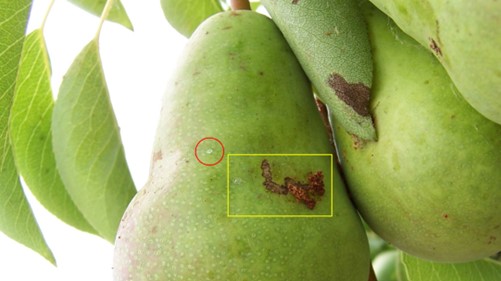Managing Codling Moth in Apple and Pear Orchards
Managing Codling Moth in Apple and Pear Orchards
“Codling Moth is so difficult to control because they may only feed and/or crawl around for a couple of hours at most, then they are beyond the depth of any insecticide as they have entered too far into the fruit,” said Allison Walston, Valent U.S.A. Product Development Manager for Insecticides.
Codling Moth Life Cycle
Codling moth overwinter as pupae and emerge as adults in the spring when temperatures rise. Pheromone traps are placed to monitor consistent male moth catches, which marks the Biofix—the starting point for degree day tracking. Tracking degree days allows growers to target specific life stages of codling moth with insecticides. Ovicides, like Esteem® 35 WP Insect Growth Regulator, are applied around 100 degree days, or when codling moth are laying eggs. Esteem 35 WP keeps the eggs from successfully maturing and not hatching.
As degree days accumulate, the next timing window is around 200 degree days, which is the beginning of egg hatch. It is important to have products like DiPel® DF Biological Insecticide Dry Flowable on the growing fruit and the laid eggs, so upon hatching, the larvae will feed on the Bt spores.
Codling Moth Symptoms
Eggs can be laid on fruit and/or leaves. They are small and opaque white when first laid, then mature to a red ring stage, and then the larva is large enough to see the black head capsule. As soon as the egg hatches, the larva begins to take nibbles—this can either be some surface feeding or the larvae can immediately burrow into the fruit. The area that was fed upon usually has a red ring around the hole and larval feces called frass will start to come out of the frass hole. The larva then makes a direct path to feed upon the seeds. This damaged fruit does not develop and will fall to the ground. The larva will crawl out and pupate in crevices against the trunk.

The above images shows devastating damage from a codling moth larva. Source: Allison Walston

The red circled area shows a codling moth egg on the surface of a pear, and the yellow box shows where an egg hatched and entered the fruit. This hatched larva fed on the pear surface before entering the fruit with frass accumulating at the entry point. Source: Allison Walston
Tips to Manage Codling Moth
Here are a few tips to manage codling moth in apple and pear orchards:
- Evaluate fruit at harvest the previous year (from pack out) for signs of pest damage
- Don’t keep wooden bins near your orchard as they harbor pests
- Monitor pheromone traps to establish your local Biofix
- Follow the degree day model to help determine the pest stage for optimal insecticide applications and results
- Use multiple methods of control, including pheromone mating disruption, Bts like DiPel DF, as well as conventional insecticides like Esteem 35 WP
Contact your local Valent team or visit the DiPel DF product page or the Esteem 35 WP product page to learn more.
Always read and follow label instructions.